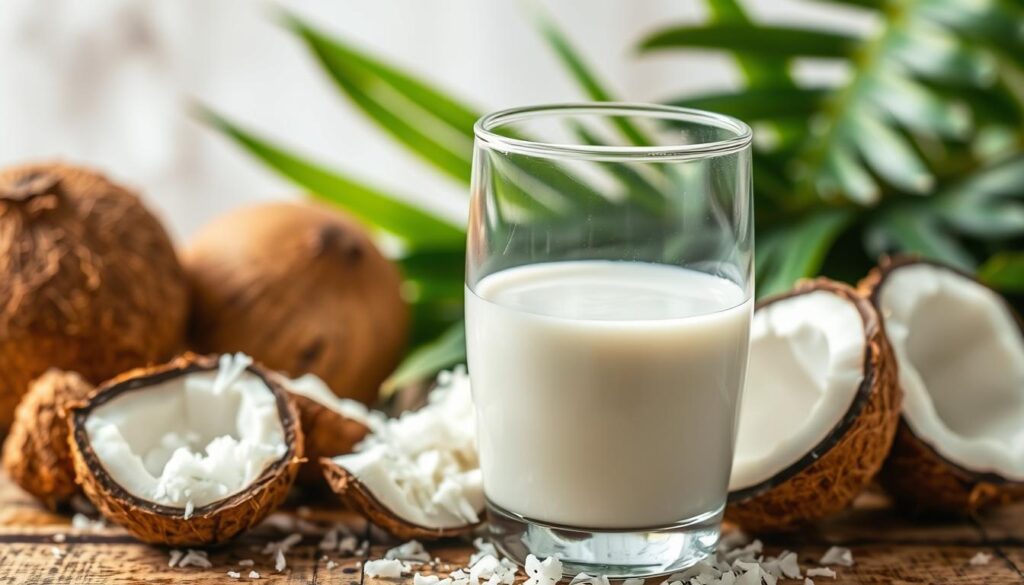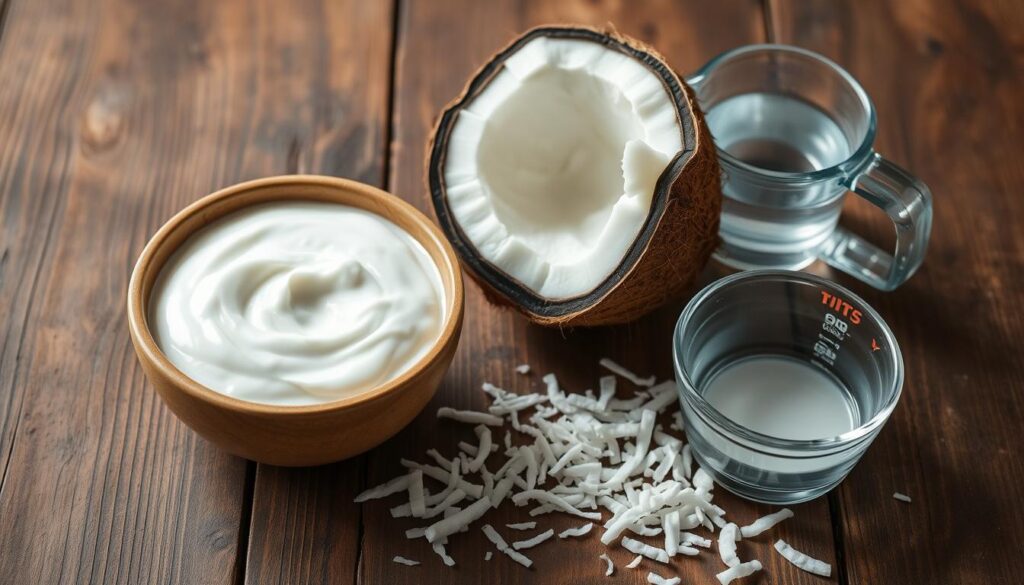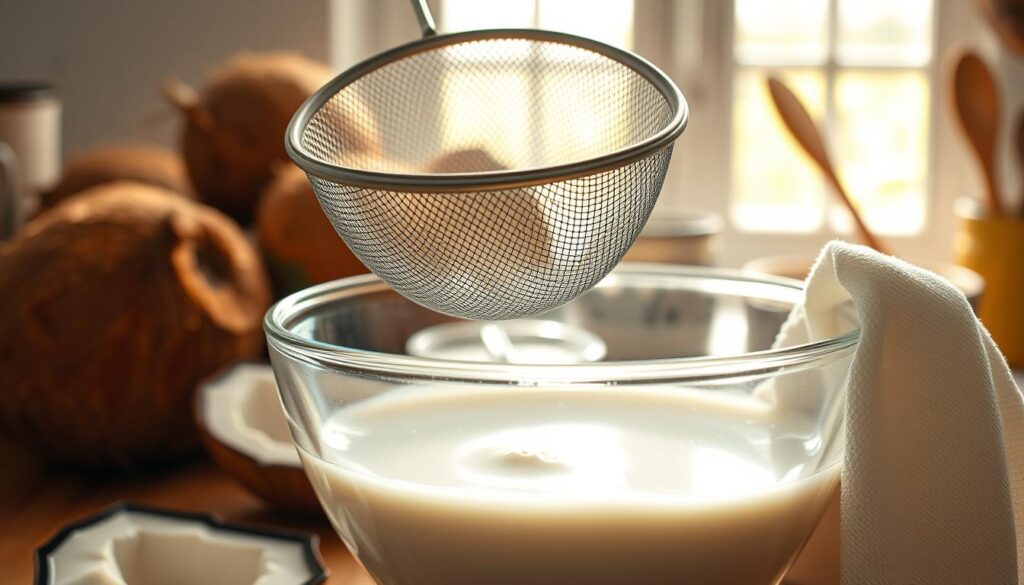Coconut milk is a versatile and creamy ingredient. It can make many recipes better, like curries and smoothies. Making it at home from coconut cream is easy and rewarding. We’ll show you how to turn coconut cream into rich, homemade coconut milk.
This DIY recipe is great for saving money, reducing waste, or controlling the quality of your ingredients. It’s a game-changer.
Key Takeaways
- Learn how to easily convert coconut cream into delicious, creamy homemade milk.
- Discover the benefits of making your own coconut milk instead of buying it pre-made.
- Understand the difference between coconut milk and coconut cream.
- Gain the knowledge and confidence to create your own DIY coconut milk at home.
- Explore the versatile uses of homemade coconut milk in a variety of recipes.
Introduction to Coconut Milk
Coconut milk is a liquid made from mature coconut meat. It’s loved in many cuisines, especially in Southeast Asia and the Caribbean. It’s known for its creamy texture and unique taste.
Benefits of Homemade Coconut Milk
Homemade coconut milk has many perks. You can avoid additives and preservatives. Plus, you can adjust the taste and texture to your liking. It’s also cheaper than buying it pre-made.
Coconut Milk vs. Coconut Cream
It’s key to know the difference between coconut milk and coconut cream. Coconut cream is thicker and has more fat, great for desserts and sauces. Coconut milk is thinner and more versatile, perfect for curries, soups, smoothies, and baked goods.

“Homemade coconut milk allows you to control the quality and flavor, making it a healthier and more affordable option.”
Ingredients You’ll Need
To make delicious homemade coconut milk, you’ll need just a few simple ingredients. The main parts are coconut cream and water. These can be mixed to create a rich, creamy milk perfect for many recipes.
Here’s a list of the ingredients you’ll need to make coconut milk from scratch:
- Coconut cream – This is the key ingredient that provides the luscious texture and flavor of the milk.
- Water – Adds the desired consistency and dilutes the coconut cream to create the milk.
- Optional flavors – You can enhance the coconut milk with ingredients like vanilla extract, maple syrup, or spices like cinnamon or cardamom.
| Ingredient | Quantity |
|---|---|
| Coconut cream | 1 cup |
| Water | 1-2 cups |
| Vanilla extract (optional) | 1 teaspoon |
| Maple syrup (optional) | 1-2 tablespoons |
| Cinnamon or cardamom (optional) | 1/2 teaspoon |
With these basic ingredients for coconut milk, you’ll have everything you need. You can use them to create a homemade version. This version can be used in a variety of what do you need to make coconut milk recipes.

Step-by-Step Guide to Making Coconut Milk
Turning coconut cream into tasty homemade coconut milk is easy and rewarding. This simple guide will help you make your own coconut milk at home. It’s packed with nutrients and delicious.
Preparing the Coconut Cream
Start by picking high-quality coconut cream. If using canned coconut cream, shake the can well before opening. This ensures everything is mixed together. Or, you can make your own by grating fresh coconut and squeezing out the liquid.
Blending the Coconut Mixture
- In a blender, mix the coconut cream with an equal amount of filtered water. For example, use 1 cup of coconut cream with 1 cup of water.
- Blend it on high speed for 2-3 minutes until it’s smooth and creamy.
- Try the coconut milk and adjust the water-to-cream ratio as you like. For thicker milk, use less water. For thinner, add more.
With this easy recipe, you can make coconut milk from coconut cream. Enjoy the fresh taste of homemade coconut milk in your favorite dishes.

Straining and Separating Coconut Milk
After blending coconut cream and water, it’s time to strain the mix. This step is key for the right consistency and taste of your coconut milk. Let’s look at the best ways to strain coconut milk and separate coconut milk and coconut meat.
To strain coconut milk well, use a nut milk bag or a fine-mesh strainer. Pour the blended mix into the bag or strainer. Let the liquid drain, leaving the pulp behind. Press the pulp gently to get as much milk as you can.

You can also use cheesecloth or a clean dish towel. Fold the cloth into layers, place it over a bowl, and pour the coconut mix onto it. Twist or squeeze the cloth to strain the milk from the pulp.
After straining, you’ll see the coconut meat left behind. This pulp is great for baked goods, smoothies, or as a dairy-free coconut substitute.
- Use the strained coconut milk right away in your recipes or save it for later.
- The leftover coconut pulp is perfect for baked goods, smoothies, or as a dairy-free coconut substitute.
“Straining coconut milk is a simple yet essential step to achieve the perfect creamy texture and rich flavor.”
By following these steps, you can strain coconut milk and separate coconut milk and coconut meat easily. Enjoy the fresh taste of your homemade coconut milk!
Coconut Milk Storage and Shelf Life
Storing your homemade coconut milk right is key to keeping it fresh and tasty. Unlike canned coconut milk, which lasts months, homemade has a shorter shelf life. How long does homemade coconut milk last? With proper storage, you can enjoy it for up to 5 days.
To store it, pour the milk into an airtight container or mason jar. Make sure to seal it well and keep it in the fridge. Don’t let it sit at room temperature, as it can spoil fast. Storing coconut milk this way keeps its creamy texture and flavor intact.
- Refrigerator: Homemade coconut milk will keep in the fridge for 4-5 days.
- Freezer: For longer-term storage, you can freeze coconut milk in an airtight container or ice cube trays. Frozen coconut milk will last for up to 3 months.
- Discard any coconut milk that develops an off-smell, changes color, or shows signs of spoilage.
“Freshly made coconut milk is a delightful addition to your kitchen, but it requires a bit more care than the canned variety. By following proper storage techniques, you can enjoy the full flavor and creaminess of homemade coconut milk for days to come.”
With these simple storage tips, you can make your homemade coconut milk last longer. Enjoy its delicious, wholesome flavor in all your recipes.
Versatile Uses of Homemade Coconut Milk
Homemade coconut milk is a versatile ingredient for many dishes. It’s not just for drinking. This creamy liquid adds flavor and richness to your cooking and baking.
Cooking with Coconut Milk
Coconut milk is great in savory dishes like curries and stews. It makes sauces and marinades creamy and flavorful. Use it as a vegan and dairy-free substitute in your recipes.
It’s also perfect for sweet dishes. Add it to smoothies, oatmeal, puddings, and baked goods for a tropical flavor. Homemade coconut milk opens up a world of possibilities in your kitchen.
| Savory Uses | Sweet Uses |
|---|---|
|
|
“Coconut milk is a kitchen staple that can transform both sweet and savory dishes with its rich, creamy texture and distinctive flavor.”
Troubleshooting and Tips
Making homemade coconut milk can be rewarding but comes with challenges. Whether you’re experienced or new, knowing how to handle issues is key. Here, we’ll cover common problems and solutions to make sure your coconut milk is always perfect.
One common issue is getting the right consistency. If it’s too thin, use more coconut cream. If it’s too thick, add a bit of water. Finding the perfect consistency is all about what you like, so feel free to experiment.
Another problem is separation. Coconut milk can separate into layers, with the cream on top. To avoid this, blend well and use it quickly. If it does separate, just stir or shake it back together.
| Troubleshooting Issue | Possible Solution |
|---|---|
| Thin, watery consistency | Increase the ratio of coconut cream to water |
| Thick, rich consistency | Add more water to thin out the milk |
| Separation of layers | Blend thoroughly and use the milk soon after preparation |
Learning these tips for making coconut milk and coconut milk troubleshooting will help you make perfect homemade coconut milk. It will also give you the confidence to try new recipes and flavors. Enjoy the process, have fun, and relish the delicious results!
Variations and Flavored Coconut Milk
Explore a world of flavors with homemade coconut milk. You can make it sweet and creamy or spicy and aromatic. This section will guide you on flavored coconut milk recipes and how to make sweetened coconut milk.
Sweetened Coconut Milk
Try sweetening your coconut milk for a rich taste. Add natural sweeteners like maple syrup, honey, or vanilla extract to the mix. This makes a creamy coconut milk perfect for sweet and savory dishes.
- Start with 1 tablespoon of sweetener per 1 cup of coconut milk and adjust to your desired level of sweetness.
- Vanilla extract, cinnamon, or a dash of nutmeg can also be added for extra flavor complexity.
- Experiment with different sweeteners to find your perfect balance of sweetness and coconut essence.
Let your taste buds explore the world of flavored coconut milk recipes. Try spiced coconut milk or infuse it with tropical fruits. This ingredient is versatile, so let your imagination run wild in the kitchen.
Conclusion
Making your own coconut milk from coconut cream is easy and rewarding. Just follow the steps in this guide. You’ll enjoy fresh, creamy homemade coconut milk in your favorite dishes.
There are many benefits to making your own coconut milk. You get to choose the ingredients and enjoy unique flavors. It’s great for adding plant-based options to your diet or trying new recipes.
Keep exploring coconut cream and try different techniques and flavors. This will help you find the best coconut milk for your cooking. With this knowledge, you’re ready to make delicious, healthy coconut milk at home.
FAQ
What are the benefits of homemade coconut milk?
Making coconut milk at home lets you control what goes into it. It’s free from additives and can save you money.
What is the difference between coconut milk and coconut cream?
Coconut milk and cream come from mature coconuts. Coconut cream is thicker and richer because it has more fat. You can often swap them in recipes.
What ingredients are needed to make coconut milk from coconut cream?
You need coconut cream and water. You can also add vanilla or sweeteners if you like.
How do I prepare the coconut cream for making coconut milk?
Open the can and scoop out the creamy part. Leave the watery liquid behind.
How do I blend the coconut cream and water to make coconut milk?
Blend the coconut cream and water together until smooth.
How do I strain and separate the coconut milk from the coconut pulp?
Strain the mixture through a fine-mesh sieve or cheesecloth. This separates the creamy milk from the pulp.
How long does homemade coconut milk last and how should it be stored?
It lasts 3-5 days in the fridge in an airtight container. You can freeze it for up to 3 months for longer storage.
How can I use homemade coconut milk in cooking and baking?
Coconut milk is great for many recipes. Use it in curries, soups, smoothies, baked goods, and desserts.
What are some tips for troubleshooting issues?
If it’s too thin, blend it again with more coconut cream. If it’s too thick, add water. Adjust to your liking.
How can I create flavored or sweetened coconut milk?
Add vanilla, cinnamon, or sweeteners like maple syrup or honey. Try different flavors to find what you like.




2 thoughts on “How to Make Coconut Milk from Coconut Cream”